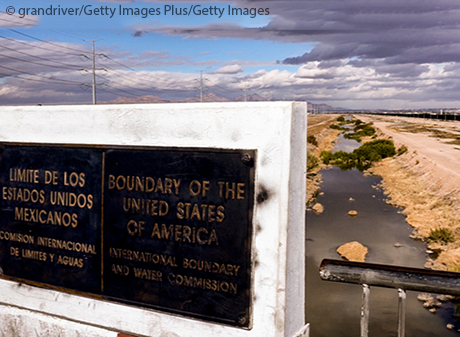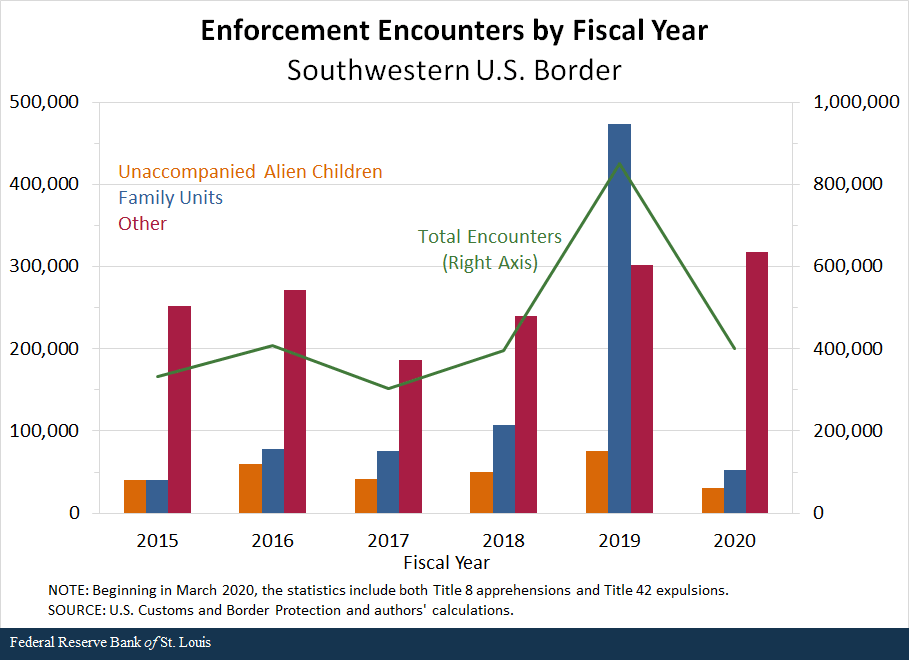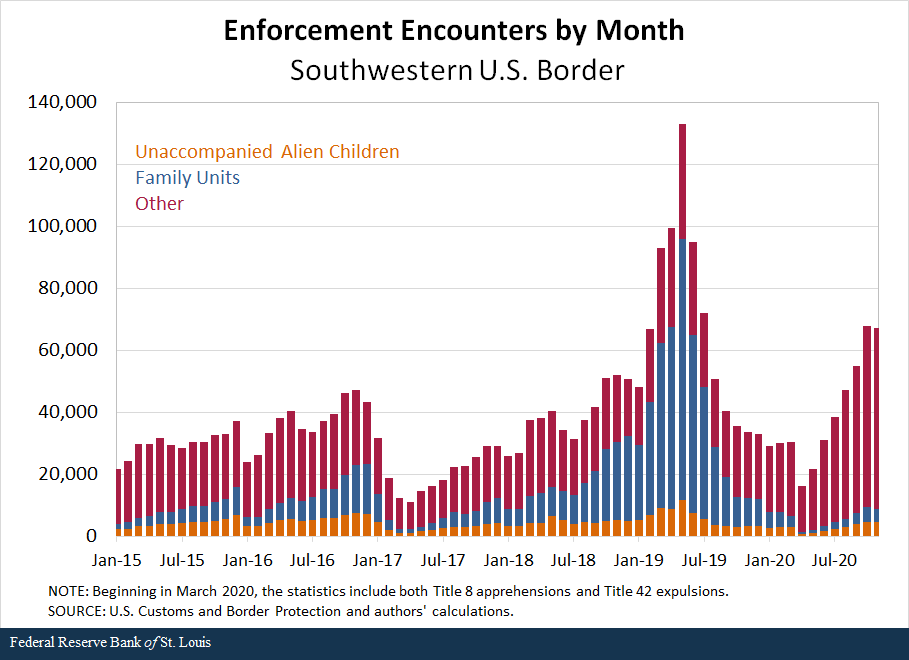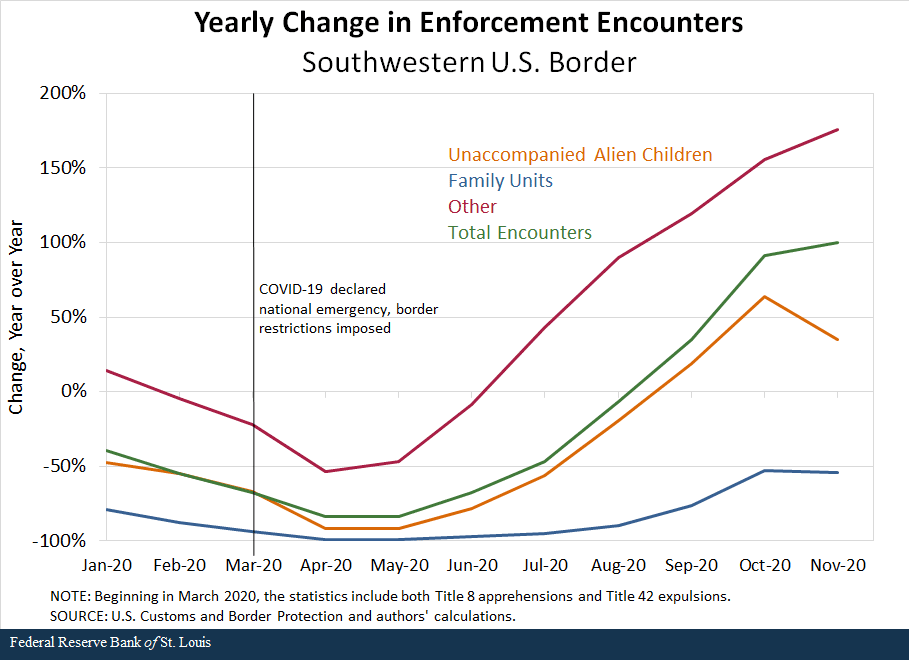COVID-19 and Unauthorized Immigration at the Southwest Border

The International Border Crossing between Juarez, Mexico and El Paso, Texas.
Although legal immigration is relatively easy to account for, it is difficult to get precise estimates of unauthorized immigration. This is because a large fraction of such immigration flows occurs along the southwestern U.S. border with Mexico, avoiding detection by border enforcement personnel; enforcement encounters at the Southwest border accounted for 99% of the U.S. total border enforcement encounters in fiscal year 2019.Enforcement encounters are composed of U.S. Title 8 apprehensions and U.S. Title 42 expulsions. Title 8 apprehensions are processed under CBP’s immigration authority; they refer to the physical control or temporary detainment of a person who is not lawfully in the U.S., which may or may not result in an arrest. Title 42 was invoked as a public health-related response to COVID-19 during March 2020. The federal government’s fiscal year begins Oct. 1 and ends Sept. 30 of the following year; for example, fiscal year 2020 began Oct. 1, 2019, and ended Sept. 30, 2020. Please refer to the Customs and Border Protection’s website for more information on the data.
At a given enforcement level, there is likely a proportionality between the thwarted attempts at unauthorized immigration and the actual flow of unauthorized immigration into the U.S. Based on this premise, we focus on the enforcement encounters data to infer unauthorized immigration flows in recent years.
Enforcement encounters involve three different types of unauthorized immigrants:Labels and definitions are defined by the U.S. Customs and Border Protection.
- Unaccompanied alien children, which refers to those under the age of 18
- Family units, which represents the numbers of individuals (either a child under age 18, parent, or legal guardian) encountered with a family member
- Other, which is the difference between total enforcement encounters and the sum of the two categories above. This difference has been identified as “single adults” since fiscal year 2019 in the data provided by U.S. Customs and Border Protection.
Enforcement Encounters by Fiscal Year
The figure below shows that total enforcement encounters sharply increased in fiscal year 2019 but then significantly declined in fiscal year 2020. The latter trend is what one would expect because of the COVID-19 related disruptions. However, somewhat surprisingly, the enforcement encounters in the “other” category actually rose in fiscal year 2020 compared with all encounters in the previous fiscal years going back to 2015. This suggests that while COVID-19’s cumulative effect on families’ and unaccompanied children’s immigration attempts has been quite negative, the pandemic has not dampened unauthorized immigration attempts by individual adults.

Enforcement Encounters by Month
The next figure presents monthly numbers starting in January 2015.

There was a dip in early 2017 and then another around the middle of 2019. COVID-19 had a sharp negative effect on all categories of enforcement encounters in April 2020, immediately following the declaration of a U.S. national emergency and the imposition of tougher border restrictions in March 2020. However, enforcement encounters have gone up strongly in recent months, driven mostly by single adults.
Percentage Change in Monthly Enforcement Encounters
Finally, the figure below displays the percentage change in the monthly number of encounters from a year earlier. The line representing family members is in negative territory throughout 2020, but there is an uptick in the remaining categories in recent months. This has led to total enforcement encounters since September 2020 to exceed their corresponding 2019 monthly levels.

Conclusion
Enforcement encounters at the Southwest border indicate a temporary reduction of unauthorized immigration attempts due to COVID-19. The composition of unauthorized immigration attempts has been starkly different in recent months compared with those in most months of 2019, with families representing a much smaller share of these recent attempts and single adults representing the vast majority. It is possible that reopening of the U.S. economy and the resulting work opportunities are driving some of these attempts at immigration by adults. However, without further analysis, it is not clear why there was such a disproportionate drop in attempted unauthorized immigration by families in recent months.
Notes and References
- Enforcement encounters are composed of U.S. Title 8 apprehensions and U.S. Title 42 expulsions. Title 8 apprehensions are processed under CBP’s immigration authority; they refer to the physical control or temporary detainment of a person who is not lawfully in the U.S., which may or may not result in an arrest. Title 42 was invoked as a public health-related response to COVID-19 during March 2020. The federal government’s fiscal year begins Oct. 1 and ends Sept. 30 of the following year; for example, fiscal year 2020 began Oct. 1, 2019, and ended Sept. 30, 2020. Please refer to the Customs and Border Protection’s website for more information on the data.
- Labels and definitions are defined by the U.S. Customs and Border Protection.
Additional Resources
- On the Economy: STEM Skills among Foreign-born Workers in the U.S.
- On the Economy: Unauthorized Immigration Attempts at the Southwest Border
- Regional Economist: Immigration: The Characteristics of Green Card Holders
Citation
Subhayu Bandyopadhyay and Praew Grittayaphong, ldquoCOVID-19 and Unauthorized Immigration at the Southwest Border,rdquo St. Louis Fed On the Economy, Jan. 14, 2021.
This blog offers commentary, analysis and data from our economists and experts. Views expressed are not necessarily those of the St. Louis Fed or Federal Reserve System.
Email Us
All other blog-related questions



